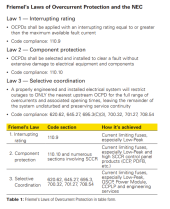That is one way to look at it. Another way is that its just a statement made in recognition of the same problem that you stated--that AIC is often not listed by LFP manufacturers or assemblers--and guidance that can be followed without knowing that info would be useful to builders.
A power of standards (which I don't believe TE-13 has the status of) is to compel people to list safety-critical specification information in order to be compliant. The manufacturers and suppliers "tail" should not be wagging the standards "dog".
If each subdivision was properly fused, with properly sized AIC and current ratings, downstream would be protected wouldn't it? Only the first fuse for each subdivision would need to handle the full AIC of the pack I think. Beyond that, lower AIC fuses are okay I think. I may be misunderstanding something.
I take TE-13 to mean that if you have say 4 parallel battery system branches, you could fuse each at say 200A, and each of those fuses would ordinarily have to deal with just the short circuit current of that string. (Exception: if that strings shorts, the other three strings fault into it. ABYC did not allow for that - another flaw in TE-13?). But after those fuses, the branches are combined, and now the available fault current is four times greater.
(Perhaps I'm misunderstanding TE-13 here, but if so I have to say it is unacceptably unclear. In constructing large battery banks you often have a single large load - a good example would be electrical propulsion - so parallel strings have to be combined. And there is often good reason not to subdivide an electrical system even when it might be technically possible.)
For example, if you have say a couple of inverters downstream, each might be fused with say 400A.
Now it is a basic principal of protection that downstream protective devices should operate first for faults that occur (immediately) downstream of them, and that they should be coordinated with upstream devices (in capacity and speed) so that the downstream device clears the fault without affecting (tripping or degrading) any upstream device. For instance, the 400A downstream fuse should melt and clear a fault in one of those inverters, without any upstream device (200A battery string fuses) getting to the melt point (after which it is suspect even if it did not rupture, and should be replaced). Class T fuses are capable of fairly close coordination, but I have no idea what level of selectivity you can achieve with lesser interrupting fuses (such as Mega fuses). As a corollary, you can mess up coordination by having say a fast, high current fuse upstream of a slow, lower current fuse of a different type.
Anyhow, that downstream device is subject to the full bolted fault current of the entire bank of 4 parallel strings (assuming the wiring resistance and inductance in between are small), so it is faced with a (nearly) 4 times greater prospective fault current than the individual string fuses are (for faults external to the battery bank). If it then failed in its duty, and the fault continued, eventually the per-string fuses would operate, but this is not what you want to happen. Among other things, then all power is lost to all consumers, and you need to replace 5 fuses - rather expensive fuses if they are Class T.
AC standards like the NEC deal with this sort of thing in great detail. They cut a certain amount of slack on protection coordination for ordinary house and industrial situations, but get rigorous for mission-critical applications like hospitals or elevators. For my boat, I want the fuses in the individual battery strings sized so they will not be affected by faults in downstream devices.
Nice to have a little extra breathing room, particularly considering the unknowns. The 20kA stated in E-11 is referenced as the minimum if short circuit current is unknown, so exceeding it is reasonable. Was the fuse more pricey than other class T fuses you looked at?
I think they were competitively priced.
Last edited:






